Innovative Design Techniques for Sinusoidal-Web Beams: A Reliability-Based Optimization Approach
Abstract
1. Introduction
2. Theoretical Background
2.1. Finite Element Analysis
2.2. Reliability-Based Optimization Framework
3. Experimental Work
4. Numerical Modeling
4.1. SIN-240
4.2. SIN-100
5. Results and Discussion
5.1. SIN-240 Results Overview
5.2. SIN-100 Results Overview
6. Conclusions
- The sensitivity of the algorithm to deviations in structural behavior is evident, emphasizing the importance of pre-emptively identifying potential failure modes for safeguarding structural integrity.
- The convergence toward optimized values, driven by a targeted reliability index (), showcases the efficacy of reliability-based optimization in tailoring beam designs to meet stringent reliability constraints.
- The derived values of web thickness () and flange thickness () ensure stability under the specified conditions and suggest an efficient utilization of materials, a crucial consideration in sustainable steel structure design.
- The stress distribution within the optimized configurations demonstrates notable improvements, particularly in reducing zones exhibiting yielded stress, ensuring structural integrity and averting plastic accumulation.
Author Contributions
Funding
Data Availability Statement
Acknowledgments
Conflicts of Interest
References
- Zhao, J.; Yang, J. Overall Stability Behavior and Design Method of Q460 High Strength Steel Welded I-Section Overhanging Beams. Thin-Walled Struct. 2023, 186, 110665. [Google Scholar] [CrossRef]
- Lindner, J. Design of Steel Beams and Beam Columns. Eng. Struct. 1997, 19, 378–384. [Google Scholar] [CrossRef]
- Poologanathan, K.; Perampalam, G.; Gunalan, S.; Corradi, M. Structural Performance of Cold-Formed Steel (CFS) Structures. Buildings 2023, 13, 1689. [Google Scholar] [CrossRef]
- Rad, M.M. A Review of Elasto-Plastic Shakedown Analysis with Limited Plastic Deformations and Displacements. Period. Polytech. Civ. Eng. 2018, 62, 812–817. [Google Scholar] [CrossRef]
- Śledziewski, K.; Górecki, M. Finite Element Analysis of the Stability of a Sinusoidal Web in Steel and Composite Steel-Concrete Girders. Materials 2020, 13, 1041. [Google Scholar] [CrossRef] [PubMed]
- Papangelis, J.; Trahair, N.; Hancock, G. Direct Strength Method for Shear Capacity of Beams with Corrugated Webs. J. Constr. Steel Res. 2017, 137, 152–160. [Google Scholar] [CrossRef]
- Driver, R.G.; Abbas, H.H.; Sause, R. Shear Behavior of Corrugated Web Bridge Girders. J. Struct. Eng. 2006, 132, 195–203. [Google Scholar] [CrossRef]
- Hassanein, M.F.; Elkawas, A.A.; El Hadidy, A.M.; Elchalakani, M. Shear Analysis and Design of High-Strength Steel Corrugated Web Girders for Bridge Design. Eng. Struct. 2017, 146, 18–33. [Google Scholar] [CrossRef]
- Ibrahim, S.A.; El-Dakhakhni, W.W.; Elgaaly, M. Fatigue of Corrugated-Web Plate Girders: Experimental Study. J. Struct. Eng. 2006, 132, 1371–1380. [Google Scholar] [CrossRef]
- Pasternak, H.; Kubieniec, G. Plate Girders with Corrugated Webs. J. Civ. Eng. Manag. 2010, 16, 166–171. [Google Scholar] [CrossRef]
- de Carvalho, A.S.; Martins, C.H.; Rossi, A.; de Oliveira, V.M.; Morkhade, S.G. Moment Gradient Factor for Steel I-Beams with Sinusoidal Web Openings. J. Constr. Steel Res. 2023, 202, 107775. [Google Scholar] [CrossRef]
- Reinders, P.; Balomenos, G.P. Lateral Torsional Buckling of Corrugated Web Plate Girders with Sinusoidal Web Profiles. Pract. Period. Struct. Des. Constr. 2022, 27, 04022051. [Google Scholar] [CrossRef]
- de Carvalho, A.S.; Hosseinpour, M.; Rossi, A.; Martins, C.H.; Sharifi, Y. New Formulas for Predicting the Lateral–Torsional Buckling Strength of Steel I-Beams with Sinusoidal Web Openings. Thin-Walled Struct. 2022, 181, 110067. [Google Scholar] [CrossRef]
- Wang, S.; He, J.; Liu, Y. Shear Behavior of Steel I-Girder with Stiffened Corrugated Web, Part I: Experimental Study. Thin-Walled Struct. 2019, 140, 248–262. [Google Scholar] [CrossRef]
- Lee, S.H.; Park, G.W.; Yoo, J.H. Analytical Study of Shear Buckling Behavior of Trapezoidal and Sinusoidal Corrugated Web Girders. Int. J. Steel Struct. 2020, 20, 525–537. [Google Scholar] [CrossRef]
- Zhang, Z.; Pei, S.; Qu, B. Cantilever Welded Wide-Flange Beams with Sinusoidal Corrugations in Webs: Full-Scale Tests and Design Implications. Eng. Struct. 2017, 144, 163–173. [Google Scholar] [CrossRef]
- Pathirana, S.; Qiao, P. Elastic Local Buckling of Periodic Sinusoidal Corrugated Composite Panels Subjected to In-Plane Shear. Thin-Walled Struct. 2020, 157, 107134. [Google Scholar] [CrossRef]
- Nikoomanesh, M.R.; Goudarzi, M.A. Experimental and Numerical Evaluation of Shear Load Capacity for Sinusoidal Corrugated Web Girders. Thin-Walled Struct. 2020, 153, 106798. [Google Scholar] [CrossRef]
- Kim, K.; Park, S.J. Analysis of Shear Buckling for Sinusoidal Corrugated Web Beam. Mech. Based Des. Struct. Mach. 2023, 51, 6863–6880. [Google Scholar] [CrossRef]
- Sebastiao, L.; Papangelis, J. Elastic Local Shear Buckling of Beams with Sinusoidal Corrugated Webs. Structures 2023, 54, 684–692. [Google Scholar] [CrossRef]
- Wang, P.Y.; Garlock, M.E.M.; Zoli, T.P.; Quiel, S.E. Low-Frequency Sinusoids for Enhanced Shear Buckling Performance of Thin Plates. J. Constr. Steel Res. 2021, 177, 106475. [Google Scholar] [CrossRef]
- Górecki, M.; Śledziewski, K. Experimental Investigation of Impact Concrete Slab on the Bending Behavior of Composite Bridge Girders with Sinusoidal Steel Web. Materials 2020, 13, 273. [Google Scholar] [CrossRef] [PubMed]
- Szép, J.; Habashneh, M.; Lógó, J.; Movahedi Rad, M. Reliability Assessment of Reinforced Concrete Beams under Elevated Temperatures: A Probabilistic Approach Using Finite Element and Physical Models. Sustainability 2023, 15, 6077. [Google Scholar] [CrossRef]
- Dániel, H.; Habashneh, M.; Rad, M.M. Reliability-Based Numerical Analysis of Glulam Beams Reinforced by CFRP Plate. Sci. Rep. 2022, 12, 13587. [Google Scholar] [CrossRef] [PubMed]
- Benjamin, J.R.; Cornell, C.A. Probability, Statistics, and Decision for Civil Engineers; Courier Corporation: North Chelmsford, MA, USA, 2014. [Google Scholar]
- Movahedi, R.A.D.M.; Lógó, J. Plastic Behaviour and Stability Constraints in the Reliability Based Shakedown Analysis and Optimal Design of Skeletal Structures. Civ. Comp Proc. 2010, 203, 1–14. [Google Scholar]
- Pimenta, R.J.; Queiroz, G.; Diniz, S.M.C. Reliability-Based Design Recommendations for Sinusoidal-Web Beams Subjected to Lateral-Torsional Buckling. Eng. Struct. 2015, 84, 195–206. [Google Scholar] [CrossRef]
- Leblouba, M.; Tabsh, S.W. Reliability-Based Shear Design of Corrugated Web Steel Beams for AISC 360 Specification and CSA-S16 Standard. Eng. Struct. 2020, 215, 110617. [Google Scholar] [CrossRef]
- Bärnkopf, E.; Jáger, B.; Kövesdi, B. Lateral–Torsional Buckling Resistance of Corrugated Web Girders Based on Deterministic and Stochastic Nonlinear Analysis. Thin-Walled Struct. 2022, 180, 109880. [Google Scholar] [CrossRef]
- Pimenta, R.J.; Diniz, S.M.C.; Queiroz, G.; Fakury, R.H.; Galvão, A.; Rodrigues, F.C. Reliability-Based Design Recommendations for Composite Corrugated-Web Beams. Probabilistic Eng. Mech. 2012, 28, 185–193. [Google Scholar] [CrossRef]
- Habashneh, M.; Rad, M.M. Reliability Based Topology Optimization of Thermoelastic Structures Using Bi-Directional Evolutionary Structural Optimization Method. Int. J. Mech. Mater. Des. 2023, 19, 605–620. [Google Scholar] [CrossRef]
- Movahedi Rad, M.; Habashneh, M.; Lógó, J. Reliability Based Bi-Directional Evolutionary Topology Optimization of Geometric and Material Nonlinear Analysis with Imperfections. Comput. Struct. 2023, 287, 107120. [Google Scholar] [CrossRef]
- Zhang, W.; Li, Y.; Zhou, Q.; Qi, X.; Widera, G.E.O. Optimization of the Structure of an H-Beam with Either a Flat or a Corrugated Web: Part 3. Development and Research on H-Beams with Wholly Corrugated Webs. J. Mater. Process. Technol. 2000, 101, 119–123. [Google Scholar] [CrossRef]
- Sokołowski, D.; Kamiński, M. Stochastic Reliability-Based Design Optimization Framework for the Steel Plate Girder with Corrugated Web Subjected to Corrosion. Materials 2022, 15, 7170. [Google Scholar] [CrossRef] [PubMed]
- Shon, S.; Yoo, M.; Kang, J.; Lee, S. Minimum Weight Design of Sinusoidal Corrugated Web Beam Using Differential Evolution Algorithm. Int. J. Steel Struct. 2015, 15, 213–225. [Google Scholar] [CrossRef]
- Shon, S.-D.M.-N.S.-J.J.-W. Development of Optimum Design Program of Sinusoidal Corrugated Web Beam Using Differential Evolution Algorithm. J. Archit. Inst. Korea Struct. Constr. 2013, 29, 21–28. [Google Scholar] [CrossRef]
- Lee, D.; Shon, S.; Lee, S. Discrete Optimum Structural Design of the Sinusoidal Corrugated Web Beam Using DE. In Proceedings of the IASS 2016 Tokyo Symposium: Spatial Structures in the 21st Century, Tokyo, Japan, 26–30 September 2016. [Google Scholar]
- Erdal, F.; Tunca, O.; Doğan, E. Optimum Design of Composite Corrugated Web Beams Using Hunting Search Algorithm. Int. J. Eng. Appl. Sci. 2017, 9, 156–168. [Google Scholar] [CrossRef]
- Smith, M. ABAQUS/Standard User’s Manual, Version 6.9; Dassault Systèmes Simulia Corp.: Johnston, RI, USA, 2009. [Google Scholar]
- Stanton, A.; Wiegand, D.; Stanton, G. Probability Reliability and Statistical Methods in Engineering Design; John Wiley & Sons, Inc.: Hoboken, NJ, USA, 2000. [Google Scholar]
- EN1990; Others Eurocode—Basis of Structural Design. BSI: London, UK, 2002.
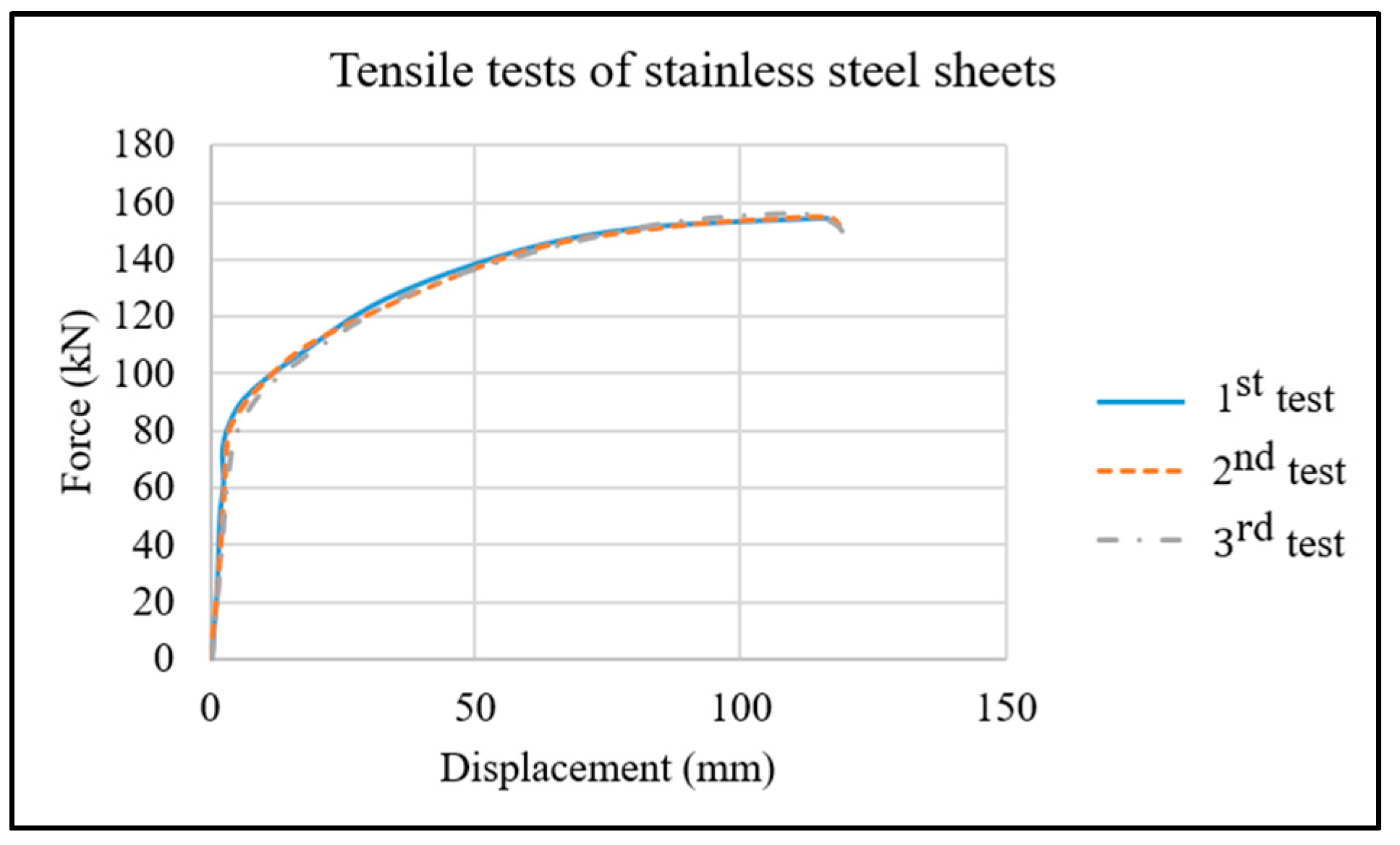


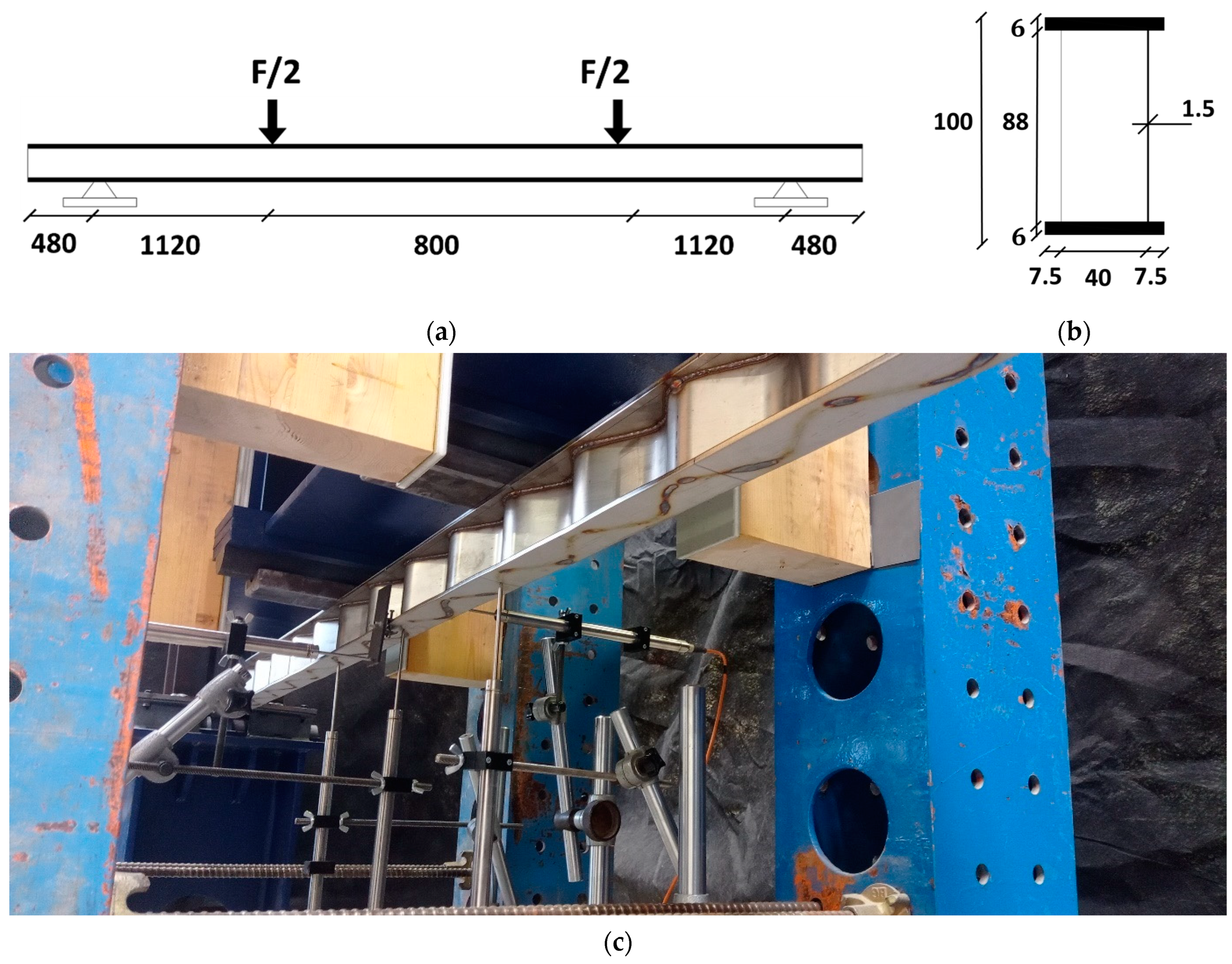

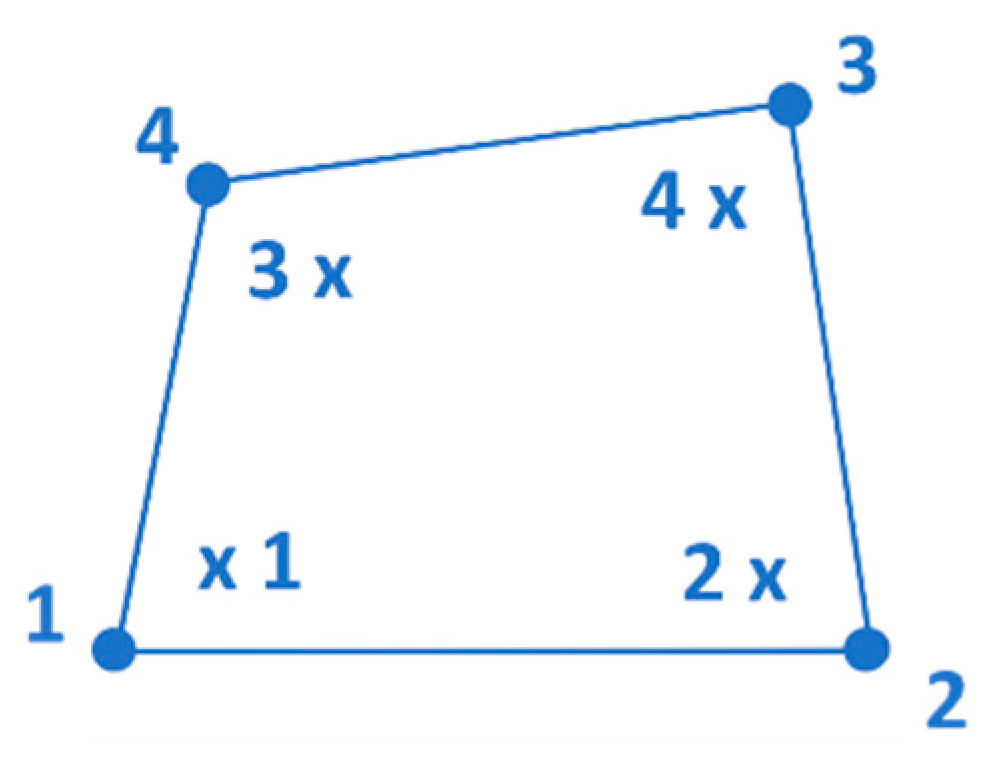
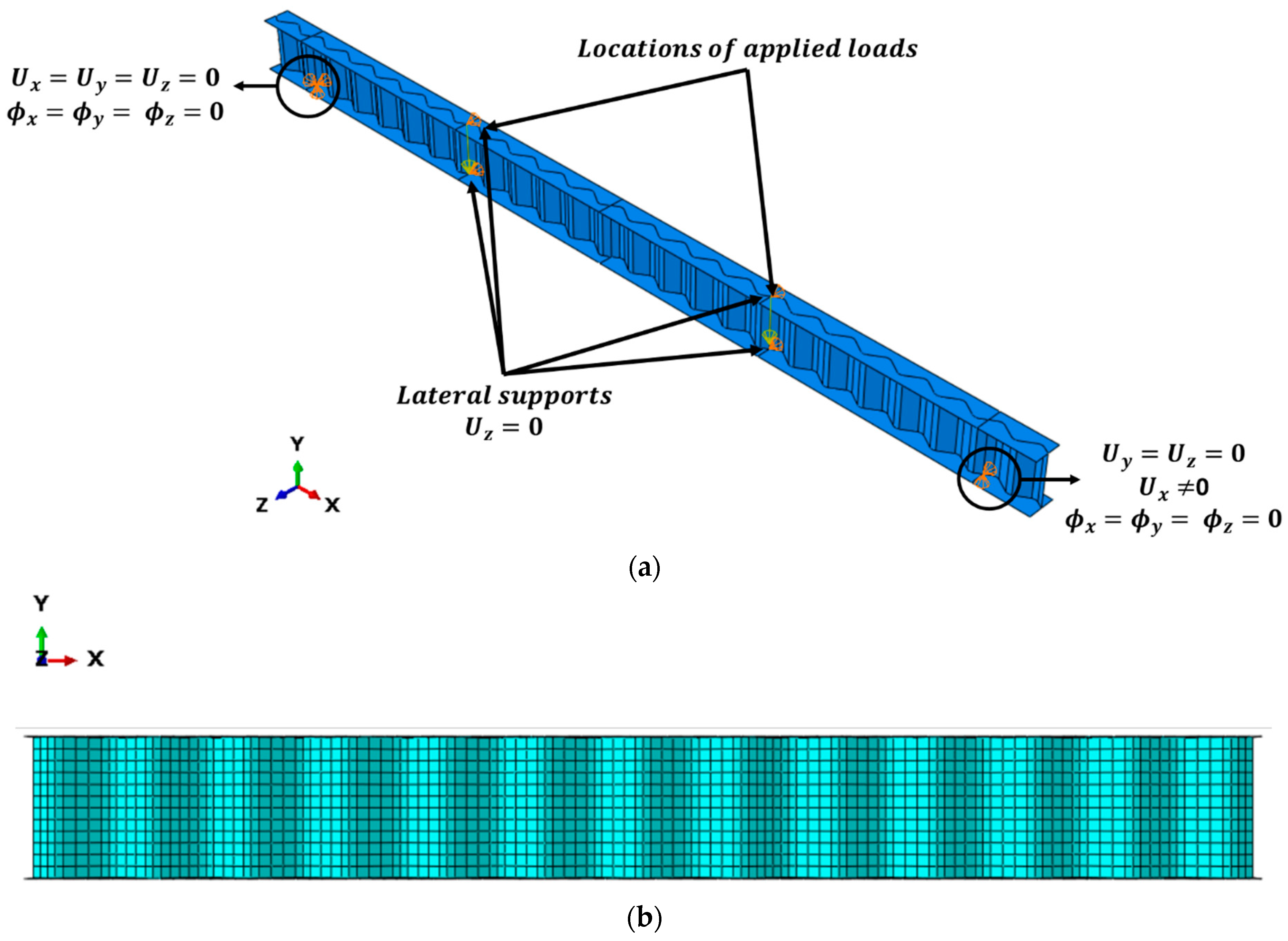



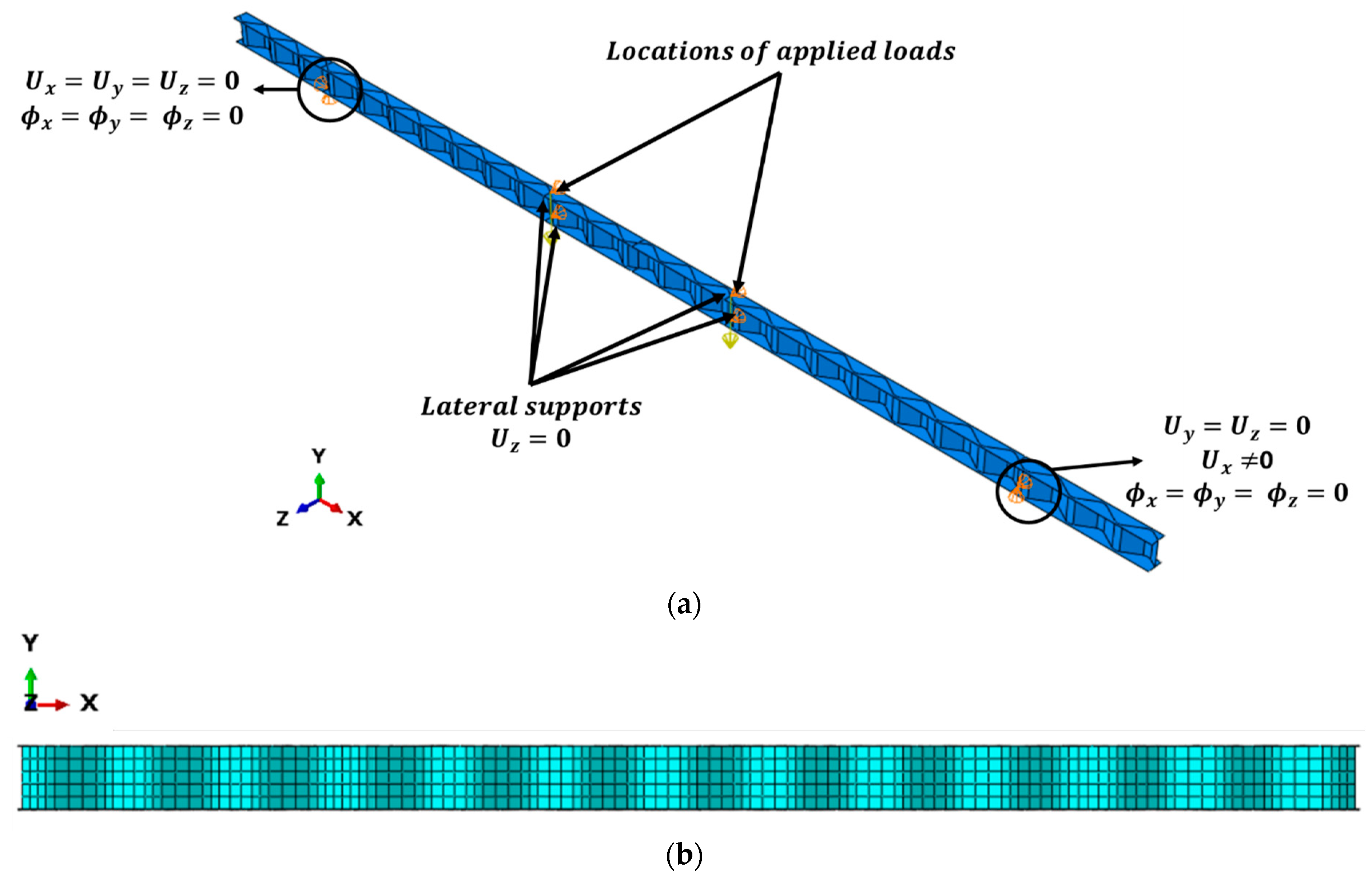
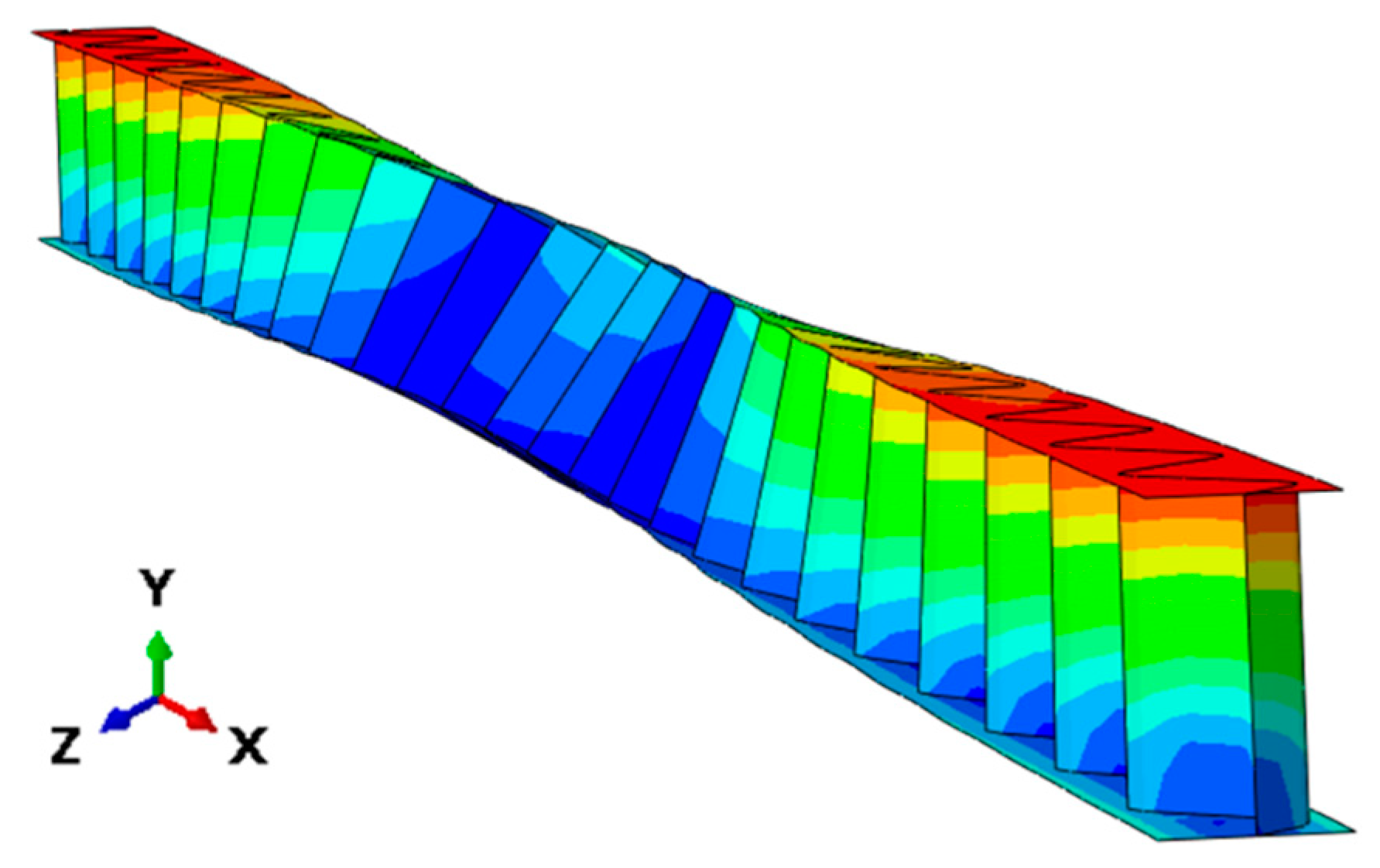

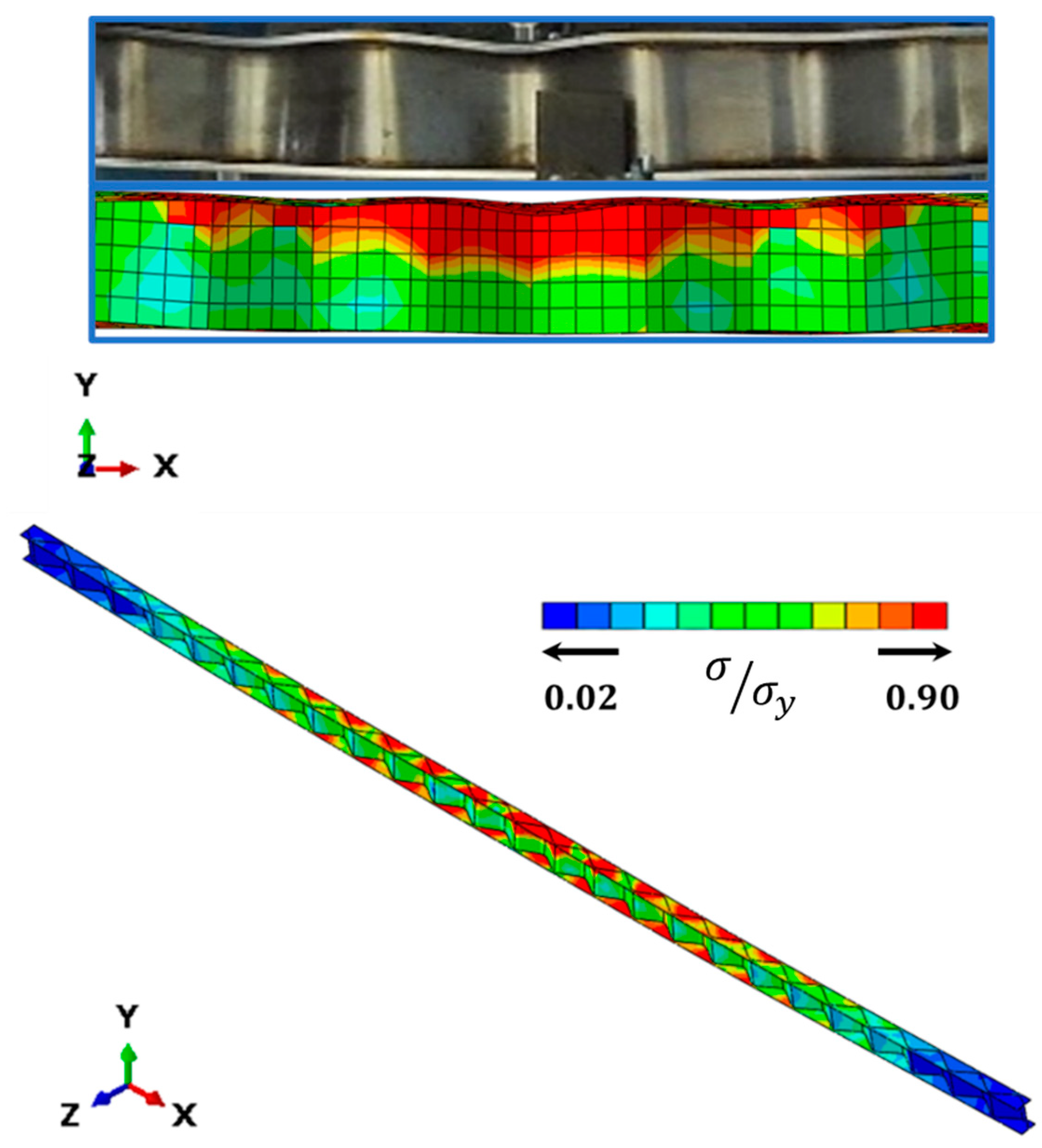
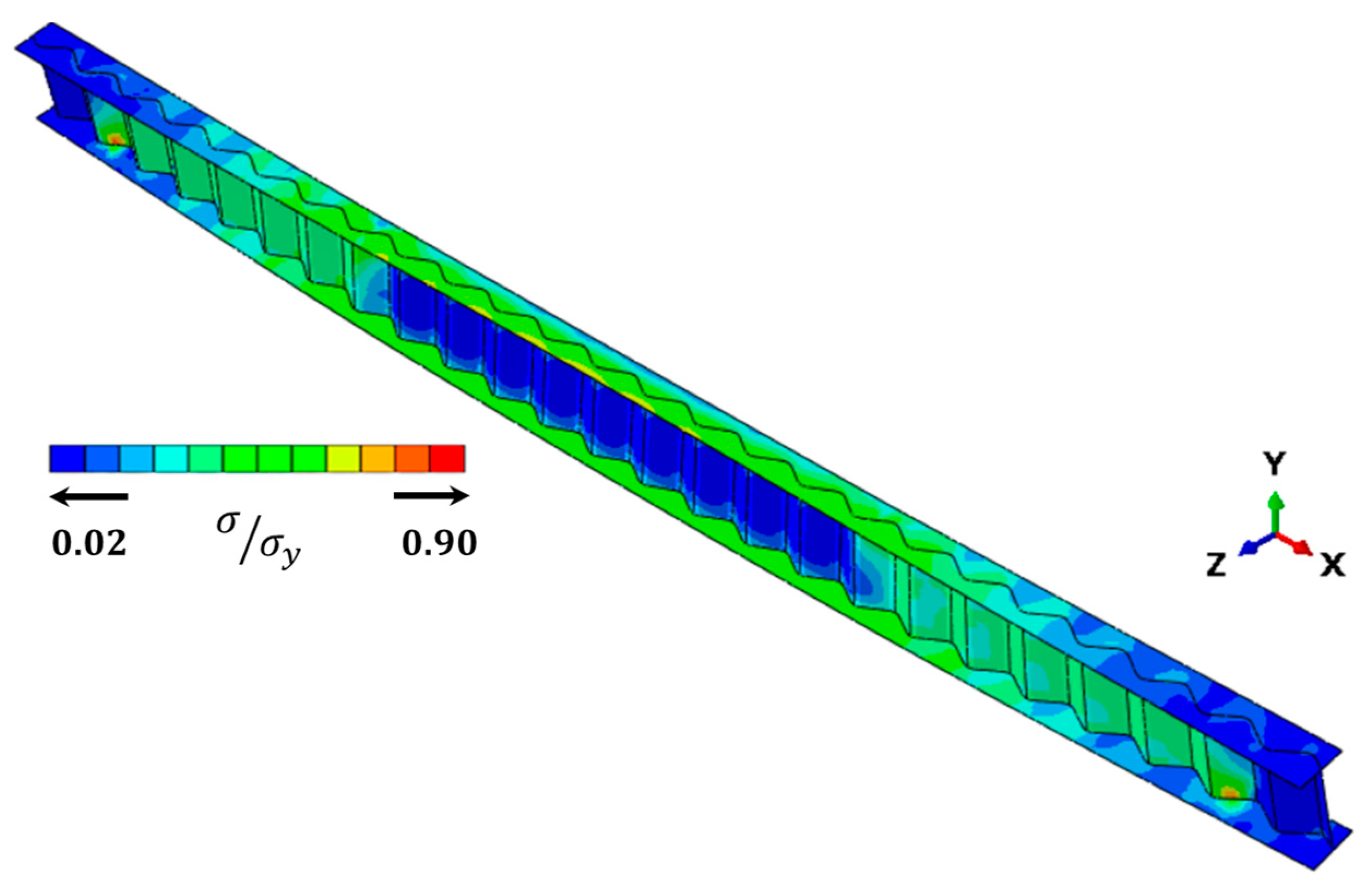
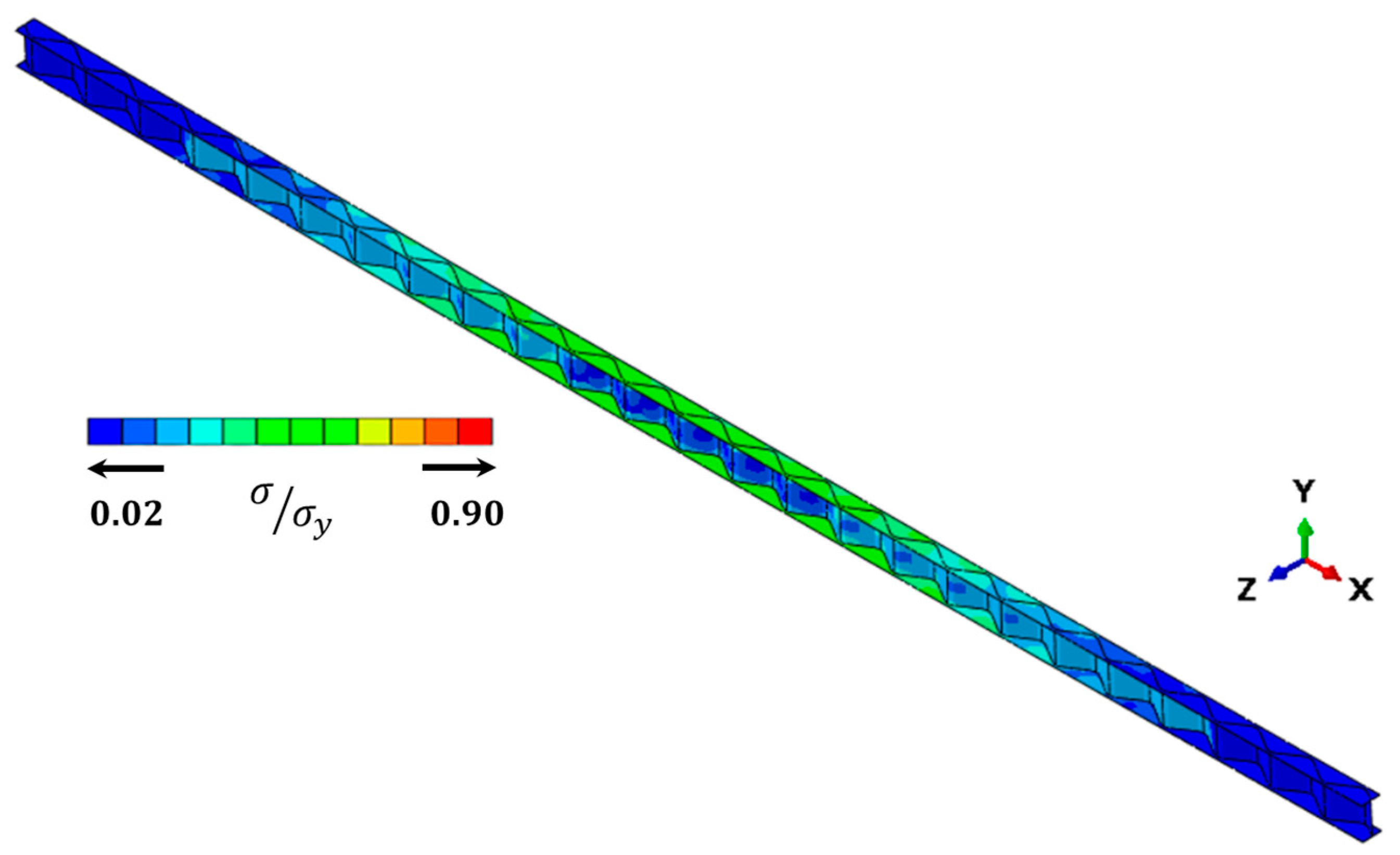
| Specimen Name | Length (mm) | Width (mm) | Height (mm) | Flange Thickness (mm) | Web Thickness (mm) |
|---|---|---|---|---|---|
| SIN-240 | 240 | 2 | |||
| SIN-100 | 100 | 1.5 |
| Beam | Parameter | Mean Value | Standard Deviation |
|---|---|---|---|
| SIN-240 | 10 | 40% | |
| 2 | 35% | ||
| 90 | 5% | ||
| SIN-100 | 6 | 40% | |
| 1.5 | 35% | ||
| 12 | 5% |
| U (mm) | ||||
|---|---|---|---|---|
| 4.00 | 2.5 | 87.3 | ||
| 3.55 | 88.89 | |||
| 3.00 | 6.00 | 2.00 | 92.90 | 20.00 |
| U (mm) | ||||
|---|---|---|---|---|
| 4.00 | 2.00 | 9.12 | ||
| 3.55 | 9.57 | |||
| 3.00 | 6.00 | 1.40 | 12.45 | 26.00 |
Disclaimer/Publisher’s Note: The statements, opinions and data contained in all publications are solely those of the individual author(s) and contributor(s) and not of MDPI and/or the editor(s). MDPI and/or the editor(s) disclaim responsibility for any injury to people or property resulting from any ideas, methods, instructions or products referred to in the content. |
© 2024 by the authors. Licensee MDPI, Basel, Switzerland. This article is an open access article distributed under the terms and conditions of the Creative Commons Attribution (CC BY) license (https://creativecommons.org/licenses/by/4.0/).
Share and Cite
Cserpes, I.; Habashneh, M.; Szép, J.; Movahedi Rad, M. Innovative Design Techniques for Sinusoidal-Web Beams: A Reliability-Based Optimization Approach. Buildings 2024, 14, 1051. https://doi.org/10.3390/buildings14041051
Cserpes I, Habashneh M, Szép J, Movahedi Rad M. Innovative Design Techniques for Sinusoidal-Web Beams: A Reliability-Based Optimization Approach. Buildings. 2024; 14(4):1051. https://doi.org/10.3390/buildings14041051
Chicago/Turabian StyleCserpes, Imre, Muayad Habashneh, János Szép, and Majid Movahedi Rad. 2024. "Innovative Design Techniques for Sinusoidal-Web Beams: A Reliability-Based Optimization Approach" Buildings 14, no. 4: 1051. https://doi.org/10.3390/buildings14041051
APA StyleCserpes, I., Habashneh, M., Szép, J., & Movahedi Rad, M. (2024). Innovative Design Techniques for Sinusoidal-Web Beams: A Reliability-Based Optimization Approach. Buildings, 14(4), 1051. https://doi.org/10.3390/buildings14041051







